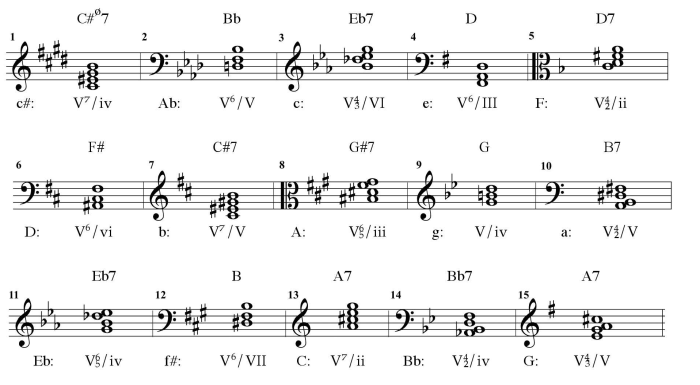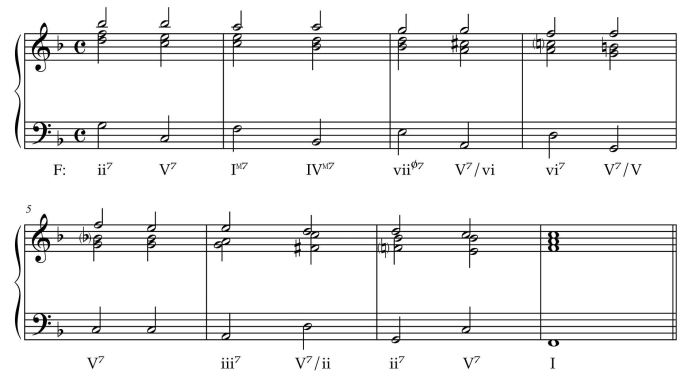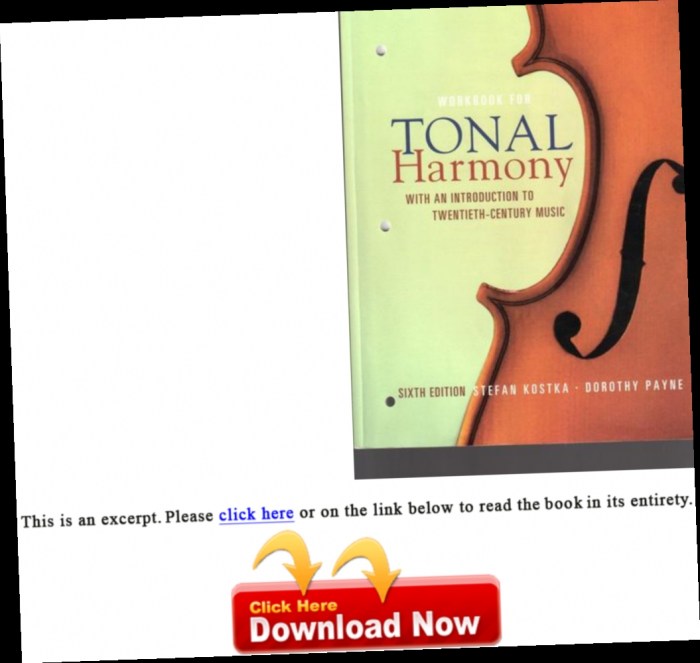Delve into the intricacies of tonal harmony with the tonal harmony 9th edition pdf, a comprehensive guide that unravels the secrets of musical theory. This definitive resource provides a thorough understanding of scales, chords, progressions, and more, empowering musicians of all levels to enhance their compositions and performances.
From the construction of major and minor scales to the complexities of chord progressions and non-chord tones, this guide offers a wealth of knowledge and practical insights. Whether you’re a seasoned professional or just starting your musical journey, the tonal harmony 9th edition pdf is an invaluable resource that will elevate your understanding of music theory.
Definition of Tonal Harmony 9th Edition
Tonal harmony is the study of the principles governing the use of chords in tonal music. Tonal music is music that is based on a key center, and the chords used in tonal music are those that are related to the key center.The
9th edition of Tonal Harmony is a comprehensive textbook that covers all aspects of tonal harmony. The book is divided into four parts:
- The first part introduces the basic concepts of tonal harmony, including scales, chords, and cadences.
- The second part discusses the use of chords in different contexts, such as in melodies, harmonies, and modulations.
- The third part covers more advanced topics in tonal harmony, such as chromaticism and atonality.
- The fourth part provides a detailed analysis of a number of musical works, including pieces by Bach, Mozart, and Beethoven.
Tonal Harmony 9th Edition is an essential resource for any student of music theory. The book is clearly written and well-organized, and it provides a wealth of information on all aspects of tonal harmony.
Major and Minor Scales

Musical scales are fundamental building blocks of tonal harmony, providing the framework for melodies, chords, and harmonies. Among the most prevalent scales are major and minor scales, each with distinct characteristics and applications in music.
A scale is a series of notes arranged in ascending or descending order, with each note separated by a specific interval. Intervals are the distance between two notes, measured in half steps or semitones. The construction of major and minor scales is based on specific interval patterns.
Major Scales
Major scales are characterized by a bright, uplifting sound. They consist of seven notes, arranged in the following interval pattern: tone, tone, semitone, tone, tone, tone, semitone. For example, the C major scale (C, D, E, F, G, A, B) follows this pattern.
Minor Scales
Minor scales, on the other hand, have a darker, more somber sound. There are three main types of minor scales: natural minor, harmonic minor, and melodic minor. Each has a slightly different interval pattern:
- Natural Minor:tone, semitone, tone, tone, semitone, tone, tone (e.g., A natural minor: A, B, C, D, E, F, G)
- Harmonic Minor:tone, semitone, tone, tone, semitone, tone and a half, semitone (e.g., A harmonic minor: A, B, C, D, E, F#, G#)
- Melodic Minor:tone, semitone, tone, tone, tone, tone, semitone when ascending, and tone, semitone, tone, tone, semitone, tone, tone when descending (e.g., A melodic minor: A, B, C, D, E, F#, G#, A when ascending, and A, G, F#, E, D, C, B, A when descending)
The interval patterns of major and minor scales create unique melodic contours and harmonic implications, shaping the overall character and expressiveness of music.
Table of Intervals in Major and Minor Scales, Tonal harmony 9th edition pdf
| Scale | Intervals |
|---|---|
| Major | tone, tone, semitone, tone, tone, tone, semitone |
| Natural Minor | tone, semitone, tone, tone, semitone, tone, tone |
| Harmonic Minor | tone, semitone, tone, tone, semitone, tone and a half, semitone |
| Melodic Minor (ascending) | tone, semitone, tone, tone, tone, tone, semitone |
| Melodic Minor (descending) | tone, semitone, tone, tone, semitone, tone, tone |
Triads and Seventh Chords: Tonal Harmony 9th Edition Pdf

Triads and seventh chords are fundamental building blocks of tonal harmony. They provide the harmonic foundation for melodies and progressions, and their understanding is crucial for any musician working with Western music.
Tonal Harmony 9th Edition PDF is a comprehensive guide to the principles of tonal harmony. It covers everything from basic concepts to advanced techniques, making it an essential resource for students and musicians of all levels. The book also includes numerous examples and exercises to help you practice and improve your skills.
If you’re interested in learning more about tonal harmony, then I highly recommend checking out which claim is arguable apex . This website provides a wealth of information on the topic, including articles, tutorials, and forums. Whether you’re a beginner or an experienced musician, you’re sure to find something helpful on this site.
So what are you waiting for? Head over to which claim is arguable apex today and start learning more about tonal harmony!
Triads
A triad is a chord consisting of three notes: the root, the third, and the fifth. The root is the fundamental note of the chord, the third is the note three scale steps above the root, and the fifth is the note five scale steps above the root.
There are two types of triads: major and minor. Major triads have a major third (four half steps) and a perfect fifth (seven half steps) above the root, while minor triads have a minor third (three half steps) and a perfect fifth above the root.
Seventh Chords
A seventh chord is a chord consisting of four notes: the root, the third, the fifth, and the seventh. The seventh is the note seven scale steps above the root.
There are four main types of seventh chords: major seventh, minor seventh, dominant seventh, and half-diminished seventh. Each type has a unique sound and function in harmony.
Inversions
Both triads and seventh chords can be inverted by placing a different note in the bass. The first inversion has the third in the bass, the second inversion has the fifth in the bass, and the third inversion (for seventh chords only) has the seventh in the bass.
Examples
Here are some examples of triads and seventh chords in the key of C major:
- C major triad: C, E, G
- C minor triad: C, Eb, G
- C major seventh chord: C, E, G, B
- C minor seventh chord: C, Eb, G, Bb
- C dominant seventh chord: C, E, G, Bb
- C half-diminished seventh chord: C, Eb, Gb, Bb
Chord Progressions
Chord progressions form the backbone of tonal music, providing structure and movement to musical compositions. They involve the sequencing of chords, guided by principles of voice leading and harmonic function.
Voice leading refers to the smooth movement of individual voices within a chord progression, ensuring melodic coherence and avoiding dissonant leaps. Harmonic function, on the other hand, assigns specific roles to chords within a progression, such as tonic (stable), dominant (tense), and subdominant (supporting).
Common Chord Progressions
Tonal music commonly employs various chord progressions, each serving a specific purpose and evoking different emotional responses:
- I- IV – V : The most fundamental progression, establishing the tonic key and providing a sense of resolution.
- I- vi – IV – V : A minor-infused variation, adding a touch of melancholy before resolving to the tonic.
- I- vi – ii – V : The “circle of fifths” progression, moving through different key centers before returning to the tonic.
- I- ii – V – I : The “Andalusian cadence,” characterized by its exotic flavor and use of the ii chord.
Non-Chord Tones

Non-chord tones are musical notes that are not part of the current chord. They add melodic interest and rhythmic variety to the music. Non-chord tones can be used to create tension and release, or to add a sense of movement and energy to the music.
Types of Non-Chord Tones
There are three main types of non-chord tones: passing tones, neighbor tones, and appoggiaturas.
- Passing tonesare notes that move smoothly between two chord tones. They are usually short in duration and do not disrupt the flow of the music.
- Neighbor tonesare notes that are adjacent to a chord tone. They create a sense of tension and release, and can add a sense of movement to the music.
- Appoggiaturasare notes that are played before the chord tone they resolve to. They create a sense of anticipation and can add a sense of drama to the music.
Examples of Non-Chord Tones
Non-chord tones can be found in many different types of music. Here are a few examples:
- The opening measures of Beethoven’s “Für Elise” feature a passing tone.
- The melody of “Twinkle, Twinkle, Little Star” contains several neighbor tones.
- The climax of Wagner’s “Tristan und Isolde” features a dramatic appoggiatura.
Modulation
Modulation is a technique used in music to change the key of a piece. It is a powerful tool that can be used to create musical variety and interest. There are several different methods of modulation, but the most common are direct modulation and pivot chords.
Direct Modulation
Direct modulation is the most straightforward way to change key. It involves simply changing the key signature and playing in the new key. This can be done at any point in a piece of music, but it is most effective when it is done at a point of harmonic tension.
Pivot Chords
Pivot chords are chords that can be used to connect two different keys. They are typically shared by both keys and can be used to create a smooth transition between them. For example, the C major chord can be used to connect the keys of C major and G major.
Examples of Modulation
Modulation is used in a wide variety of music, from classical to popular. Some famous examples of modulation include:
- The first movement of Beethoven’s Symphony No. 5, which modulates from C minor to B flat major.
- The chorus of the Beatles’ song “Hey Jude,” which modulates from F major to B flat major.
Harmonic Analysis

Harmonic analysis involves examining the chordal structure of a musical piece to understand the progression and relationships between chords. It plays a crucial role in music theory, aiding in understanding the harmonic framework and the composer’s intent.
There are several approaches to harmonic analysis. One common method is Roman numeral analysis, which assigns Roman numerals to chords based on their function within the key. Another approach is Schenkerian analysis, which focuses on hierarchical relationships between chords and the underlying harmonic structure.
Roman Numeral Analysis
In Roman numeral analysis, chords are labeled with Roman numerals to indicate their function within the key. The tonic chord is represented by I, the subdominant by IV, the dominant by V, and so on. These chords form the harmonic framework of a piece, and their progressions create a sense of movement and resolution.
For example, the following chord progression in the key of C major can be analyzed using Roman numerals:
“`C
- G7
- C
- F
- G7
- C
“““I
- V7
- I
- IV
- V7
- I
“`
This progression Artikels the basic harmonic structure of a typical cadence in tonal music.
Schenkerian Analysis
Schenkerian analysis focuses on the hierarchical relationships between chords. It identifies the underlying harmonic structure of a piece, which is often represented in a hierarchical diagram called a Schenkerian graph.
Schenkerian analysis helps reveal the long-range harmonic progressions and the structural relationships between chords. It provides a deeper understanding of the harmonic organization of a musical piece.
Helpful Answers
What is the significance of tonal harmony in music theory?
Tonal harmony forms the foundation of Western music, providing the framework for chord progressions, melodies, and overall musical structure.
How does the tonal harmony 9th edition pdf differ from previous editions?
The 9th edition includes updated content, revised exercises, and expanded sections on contemporary harmonic techniques.
What are the benefits of using the tonal harmony 9th edition pdf as a learning resource?
The guide offers a systematic approach to learning tonal harmony, with clear explanations, numerous examples, and practice exercises.